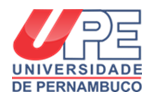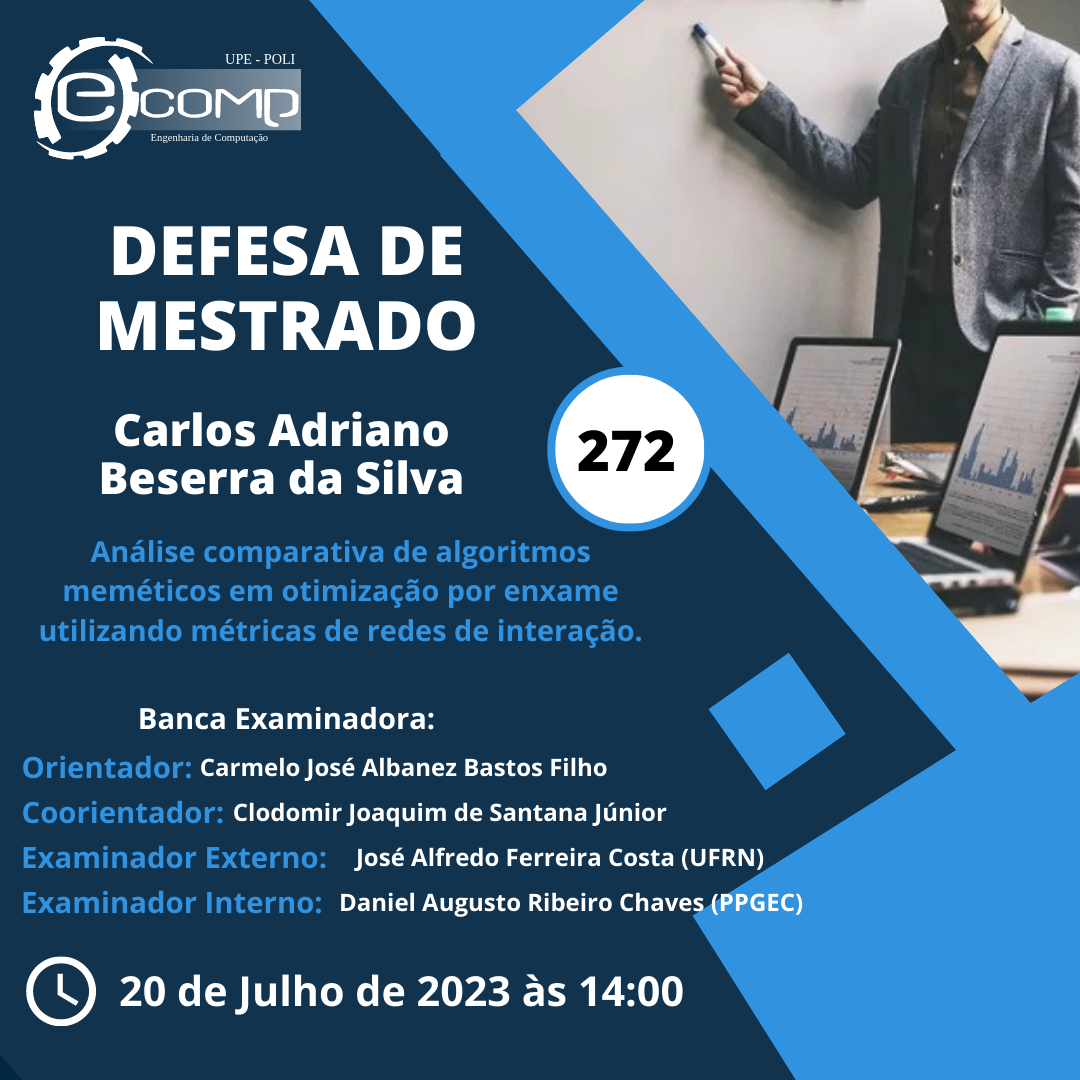Eventos
Divulgação - Defesa Nº 272
Aluno: Carlos Adriano Beserra da Silva
Título: “Análise comparativa de algoritmos meméticos em otimização por enxame utilizando métricas de redes de interação”.
Orientador: Carmelo José Albanez Bastos Filho
Examinador Externo: José Alfredo Ferreira Costa (UFRN)
Examinador Interno: : Daniel Augusto Ribeiro Chaves (PPGEC)
Data-hora: 20 de Julho de 2023 às 14:00h
Local: Formato Remoto
Resumo:
"Esta dissertação analisa e compara algoritmos meméticos em problemas de otimização por enxame. Os algoritmos meméticos são uma abordagem que combina as vantagens da otimização por enxame com a busca local, visando melhorar a eficiência e a qualidade das soluções encontradas. Foram realizadas avaliações da diversidade e qualidade das soluções geradas pelos algoritmos em diferentes topologias de PSO (Particle Swarm Optimization) utilizando métricas como a Interaction Diversity e a Portrait Divergence. Os resultados revelaram padrões distintos de exploração e explotação em cada algoritmo, fornecendo informações sobre o seu desempenho e comportamento ao longo do processo de otimização. Os resultados contribuem para uma compreensão mais profunda do desempenho e das características dos algoritmos meméticos em problemas de otimização de enxames, ajudando na seleção e desenvolvimento de abordagens práticas para a resolução de problemas complexos."
Divulgação - Defesa Nº 271
Aluna: Rafaela Laís de Barros Barbosa
Título: “Sistema híbrido com Deep Learning para detecção de trincas de concreto: uma abordagem utilizando Transfer Learning e Stacking”
Orientador: Bruno José Torres Fernandes
Examinador Externo: Leandro Honorato de Souza Silva (IFPB)
Examinador Interno: João Fausto Lorenzato de Oliveira (PPGEC)
Data-hora: 30 de Junho de 2023 às 10:00h
Local: Formato Presencial - Sala i4, Bloco C, 1 Andar
Resumo:
"A detecção de fissuras no concreto ainda é um problema rotineiro e de alto impacto, principalmente em estruturas como pontes, edifícios e viadutos. Muitos estudos estão sendo desenvolvidos para desenvolver uma solução robusta, precisa e confiável para classificação de imagens. No entanto, ainda há espaço para explorar diferentes abordagens e melhorar a precisão da classificação de trincas, por exemplo, combinando as saídas de diferentes classificadores, gerando um sistema que obtém grande generalização e funciona bem em diferentes conjuntos de dados. Propomos um método de ensemble para classificação de imagens usando a técnica de Stacking. Em nosso estudo, utilizamos a classificação de fissuras no concreto. Primeiro, treinamos cinco modelos de redes neurais convolucionais, ou seja, VGG16, VGG19, MobileNet, Xception e ResNet, para classificar imagens de fissuras no concreto. Em seguida, combinamos as previsões de saída desses modelos como entradas para um modelo Random Forest. Os resultados mostram que a abordagem Stacking proposta superou a abordagem Transfer-Learning sozinha e a técnica ensemble Learning. A abordagem Stacking alcançou uma precisão de 97,6%, em comparação com a precisão de Transfer-Learning de 92,5% e a média dos modelos de 90,7%, ambas do conjunto de dados de teste. Quando nosso modelo foi aplicado a um teste cruzado usando o conjunto de dados Bridge Crack Detection, encontrou uma precisão de 98,5% e uma precisão de 98,3%. Nossos resultados demonstram a eficácia da aprendizagem em detectar fissuras no concreto. Abordagens como essa podem melhorar a precisão e a robustez dos sistemas de detecção de trincas em aplicações do mundo real, auxiliando as inspeções nesse setor."
Divulgação - Defesa Nº 270
Aluno: Anderson Alves de Souza
Título: “Avaliação da influência de um assistente virtual no perfil de engajamento de estudantes em ambientes EAD”
Orientador: Alexandre Magno Andrade Maciel
Coorientador: Pedro Henrique de Barros Falcão
Examinador Externo: Ariane Nunes Rodrigues (UPE)
Examinador Interno: Cleyton Mario de Oliveira Rodrigues (PPGEC)
Data-hora: 28 de Junho de 2023, às 14:30h.
Local: Formato Online - Google Meet (https://meet.google.com/vbc-juqt-pdd)
Resumo:
"Com o rápido avanço da tecnologia e o crescimento da educação a distância (EAD), surge a necessidade de explorar e compreender como os assistentes virtuais podem impactar o engajamento dos estudantes nesse ambiente. Este estudo teve como objetivo avaliar a influência de um assistente virtual no perfil de engajamento de estudantes em um curso online. Para alcançar esse objetivo, um experimento foi conduzido com um grupo de 40 estudantes onde o curso foi realizado no Moodle em rede local. Os alunos iniciaram o curso sem o Avatar Educação e depois o Avatar Educação foi inserido no ambiente. A avaliação do engajamento dos estudantes foi realizada por meio de indicadores como o número de acessos ao fórum, Número de mensagens postadas no fórum pelo estudante, Número de atividades completas no prazo correto, Número de acessos ao AVA e Notas finais. Além disso, foram aplicados questionários para coletar percepções subjetivas dos estudantes sobre a influência do Avatar Educação no perfil de engajamento dos alunos. Os resultados mostraram que quando o Avatar Educação foi inserido no Moodle,os alunos apresentaram um maior nível de comprometimento. Para realizar o agrupamento dos alunos, foi utilizado o K-means, Os estudantes que utilizaram o Avatar Educação relataram uma maior sensação de apoio e orientação durante o curso, o que contribuiu para sua motivação e comprometimento com as atividades. Esses achados sugerem que a presença de um Avatar Educação pode influenciar no perfil de engajamento dos estudantes em ambientes de EAD. Os resultados deste estudo fornecem insights valiosos para instituições educacionais e desenvolvedores de plataformas de EAD, indicando que a incorporação de assistentes virtuais."





